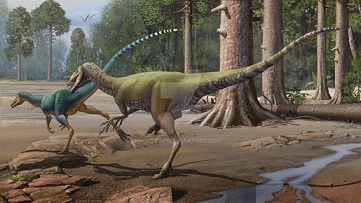
The Santanaraptor is a captivating dinosaur that offers a unique window into the prehistoric world. This lesser-known theropod dinosaur lived approximately 110 million years ago during the Early Cretaceous period. While it may not share the fame of its larger relatives like the Tyrannosaurus rex, the Santanaraptor is a fascinating subject of study for paleontologists and dinosaur enthusiasts alike.
Santanaraptor owes its name to the Santana Formation of Brazil, where its fossilized remains were unearthed. The name Santanaraptor is a combination of Santana, which denotes the formation, and raptor, derived from the Latin word meaning thief or plunderer. This name hints at the creature's presumed carnivorous nature.
| Name: | Santanaraptor dinosaurs |
| Size: | Around 5-6 feet in length,100-200 pounds in weight. |
| Main Facts: | Santanaraptor, an Early Cretaceous theropod, had relatively long arms, suggesting unique adaptations compared to other small carnivorous dinosaurs. |
Santanaraptor thrived in the Santana Formation of Brazil, an environment characterized by lush tropical vegetation and a diverse array of prehistoric life. It coexisted with various other dinosaurs, including herbivores and smaller carnivores. Its smaller size and agility might have enabled it to exploit different ecological niches and pursue a variety of prey species.

Santanaraptor was a relatively small dinosaur, measuring about 5 to 6 feet in length. This diminutive size sets it apart from some of the larger and more iconic theropods, making it a remarkable subject for study. Its smaller stature suggests it may have been swift and agile, characteristics suited for hunting smaller prey and navigating its environment.
The skeletal remains of Santanaraptor provide valuable insights into its physical features. Like other theropods, it had a slender body and sharp, serrated teeth ideally suited for a carnivorous diet. Its hind limbs were robust, indicating that it possessed the ability for rapid movement, likely enabling it to pursue and capture prey effectively.
One notable aspect of Santanaraptor's anatomy is its arms. Unlike some theropods with vestigial or non-functional arms, Santanaraptor had relatively long arms equipped with formidable grasping claws. These arms could have been used for various purposes, such as capturing prey, manipulating objects, or even engaging in display behaviors during mating rituals.
While much about Santanaraptor's behavior remains speculative due to limited fossil evidence, it is thought to have been an active predator. It may have hunted alone or in packs, relying on its sharp teeth and clawed arms to secure food in a competitive ecosystem. The versatility of its arm anatomy raises intriguing questions about its behavior and possible uses for its arms beyond hunting.
Santanaraptor, a small theropod dinosaur from the Early Cretaceous period, measured about 5-6 feet in length. With a slender body, sharp serrated teeth, and robust hind limbs, it was well-suited for carnivorous pursuits. Notably, it possessed relatively long arms with grasping claws, hinting at potential multifunctional uses.
These dinosaurs thrived in the lush tropical environment of the Santana Formation in Brazil, possibly hunting alone or in packs, though their specific behaviors remain speculative. Despite their smaller size, Santanaraptors were agile predators that played a role in the complex ecosystem of their time.
Santanaraptor is a dinosaur that belongs to the group of theropods, which includes famous relatives like Tyrannosaurus rex and Velociraptor. Comparing Santanaraptor to other dinosaurs sheds light on its unique features and its place in the evolutionary history of theropods.
Santanaraptor, like other theropods, shares the fundamental characteristics of this dinosaur group, including a bipedal stance, sharp teeth, and a carnivorous diet.
Santanaraptor, similar to other theropods, was a carnivore, preying on smaller animals, and its sharp teeth were adapted for tearing flesh.
Santanaraptor was relatively small, estimated to be about 6 feet (1.8 meters) in length. In contrast, other theropods like Tyrannosaurus rex could reach lengths of over 40 feet.
Santanaraptor lived during the Early Cretaceous period, while some other theropods, like T. rex, lived during the Late Cretaceous. This temporal difference reflects changes in the Earth's fauna and flora.
Santanaraptor fossils have been found in Brazil, indicating a presence in South America. In contrast, other theropods lived on different continents, showcasing the global distribution of theropods.
Santanaraptor had a lightweight body and likely displayed agility in hunting, which is different from the bulkier build of some other theropods.
Being a smaller theropod, Santanaraptor may have occupied a different ecological niche than larger theropods like T. rex, possibly preying on smaller prey and interacting with different species in its ecosystem.